John Reppion's Blog, page 3
December 2, 2024
Redragon Star Blade K707 Pro keyboard review

The lovely people at Redragon have sent me one of their Star Blade K707 Pro keyboards to try out.
It doesn’t smell like Parma Violets, and I haven’t tasted it (I’m thorough in my reviews, but I’m not that thorough), but the K707 definitely does have a very Parma Violet-like look to it. Which is great. I’m always a fan of a board with an out-of-the-ordinary look and colour scheme.
The Star Blade K707 Pro is an 87 key / 80% keyboard. It has an ANSI layout, is compatible with Mac and Windows (switch at the back to change modes), and connects via USB-C wired, or BlueTooth 3.0/5.0 and 2.4Ghz wireless. There’s a three position switch to select the connection mode, and the wireless dongle is stashed in a niche on the underside of the board. It has a 4000 mAh onboard battery.

The K707 comes with Redragon’s own custom Mint Mambo linear switches, which feel good and are very responsive. The switches are hot-swappable, meaning that they can be easily swapped out for other 3/5-pin switches.
The K707 is loaded with 5 dampening layers: 3.5mm PO foam, IXPE switch foam, a PET sound pad, bottom socket foam, silicone bottom pad, and a silicone gasket. This, combined with the Mint Mambo switches, mean that the K707 is perfect for use in an environment where a loud, clicky, keyboard might irritate or interrupt others.
The K707 weighs about 1 kg, so it’s perfect for on-the-go-use. It has two-postion flip down feet, so the typing angle can be adjusted to suit the user.
The K707 has the standard Redragon backlights, with all the usual customisation options. A solid blue or purple backlight works particularly well with the colour scheme. The keycaps are PBT with a OEM rounded profile, and feel great.

The K707 is a good-looking, really nice feeling keyboard and a great all-rounder. Especially for those who aren’t comfortable using a smaller board, since it has everything but the Num Pad.
The Star Blade K707 Pro is available from Redragon for £ 45 GBP / $ 55 USD.
The post Redragon Star Blade K707 Pro keyboard review first appeared on moorereppion.November 19, 2024
Epomaker RT80 keyboard review – a gasket-mounted board with a touch screen
More keyboards from Epomaker? Yes! Their generosity knows no bounds. This time they sent me the very professional RT80.
The RT80 is an 83 key / 75% keyboard. It has an ANSI layout and is compatible with Mac, Windows, and Android. The RT80 connects wired via USB-C, or via Wireless 2.4GHz and Bluetooth 5.0. There’s a three-position switch at the top right of the board to select your connection mode (I always prefer this to a keyboard shortcut). The RT80 also has an impressively large 5000mAh onboard battery.
The RT80 comes in a choice of Grey White or Black colourways. I got Black, which looks great with the backlights set to a solid frosty light blue. Keycaps are double-shot PBT dye-sub Cherry Profile (white characters on black).
The RT80 comes with a choice of Epomaker Flamingo or Wisteria (linear) switches. I got the Wisterias again, which I’m really getting to like. The switches are hot-swappable, meaning that they can be easily swapped out for other 3/5-pin switches with no need for soldering or unnecessary messing about.
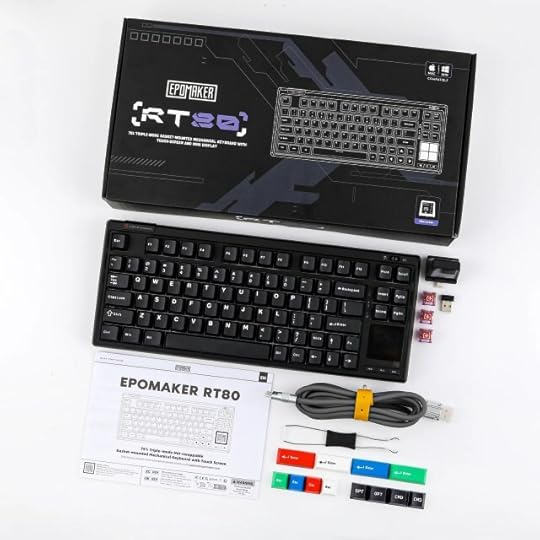
The body of the RT80 is made of ABS Plastic and includes five layers of sound and feel-improving materials: Poron sandwich foam, IXPE switch pad, PCB foam, PET film, and case foam. Paired with the gasket mount structure, these materials help dampen vibrations, reduce typing noise. Finely tuned plate-mounted stabilizers further reduce unwanted rattling.
The RT80 weighs 1.5kg, so it’s fairly weighty, but not crazily heavy. Definitely still very much a portable board as well as a perfect office one. It has two-position flip-out feet with silicon pads so that the typing angle can be adjusted to a substantial degree.
The RT80 has south-facing RGB backlights with all the usual customisation options, and more available via the free-to-use Epomaker software.
Like the RT65, the RT80 comes with a detachable RT100 Mini Display, which plugs in inside the little compartment that houses the Wireless dongle at the rear of the board. The screen displays time/date, battery status, and connection mode. It can also be loaded with custom images and animations via the Epomaker software.
But the RT80 doesn’t just have one display, it has two! A 1.54-inch touch screen sits at the bottom right of the board, with a trio of media buttons (back, play/pause, and forward) below it. The touch screen displays the Epomaker logo until you tap it, and then a grid of four icons appears. By default, these are shortcuts to Settings, Search, Zoom in, and Zoom out. Swipe sideways and you get to another four-panel grid, this time with Cut, Mute, Vol+, and Vol- on it. Using the Epomaker software, you can also add your own shortcuts to any application to the touch screen menu.

The RT80 looks and feels like a high-end office keyboard, but for a solid, stable, 75% board with all the extras it has, it’s surprisingly light. The RT100 Mini Display is a fun and functional little optional add-on, but the 1.54-inch touch screen is a genuinely useful additional interface.
As I said at the very beginning of this review, the RT80 feels like a very professional keyboard to me, but I definitely don’t mean that in a bad way – not that it’s boring, or stuffy, or anything like that. I think a lot of people who aren’t already interested in mechanical keyboards could be converted by the RT80.
The present-giving season is nearly upon us once more, and the RT80 could make the perfect gift for someone who doesn’t yet know how much they need it. Or you could just treat yourself.
The RT80 is available from Epomaker for $95.99 USD.
The post Epomaker RT80 keyboard review – a gasket-mounted board with a touch screen first appeared on moorereppion.November 17, 2024
Epomaker RT65 keyboard review – a keyboard and mouse in one
Epomaker have once again very kindly sent me one of their keyboards to try out. This time it’s the feature-packed RT65.
The RT65 is a 67 Key / 65% keyboard. It has an ANSI layout, is compatible with Mac, Windows and Andoid, and connects via USB-C, Bluetooth 3.0/5.0, and 2.4 Ghz wireless (dongle stashed in a little compartment at the rear left of the board). A two-position on/off switch at the top right of the board switches between wired and wireless modes. The RT65 also has a 3000mAh onboard battery.
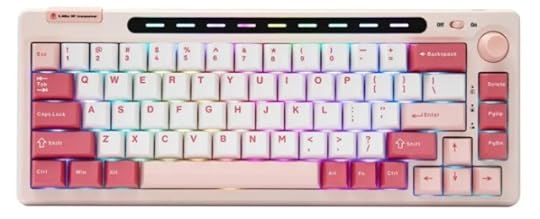
The RT65 comes in a choice of Grey White or Pink White colourways. I got Pink, because why not? Keycaps are Cherry profile PBT and match the colour scheme of the board, with pink characters on the white keys and white characters on the pink.
The RT65 comes with a choice of Epomaker Flamingo or Wisteria (linear) switches. I got the Wisterias which, even though I’m not usually a fan of linear switches, seem to suit this board well. The switches are, of course, hot-swappable, meaning that they can be easily swapped out for other 3/5-pin switches with no need for soldering or unnecessary messing about.
The RT65 incorporates five layers of sound and feel-enhancing materials, including Poron sandwich foam, IXPE switch pads, socket foam, PET film, and case foam. Combined with a gasket mount, these layers dampen vibrations, soften keystrokes, and minimize noise, creating a deeply satisfying and smooth typing experience. Finely tuned plate-mounted stabilizers further reduce unwanted rattling, ensuring every key press is consistent and enjoyable.
The RT65’s body is plastic and weighs just under 70g, making it a very lightweight, portable board. Four silicone feet on the underside of the board ensure that it’s stable despite its featherweight.
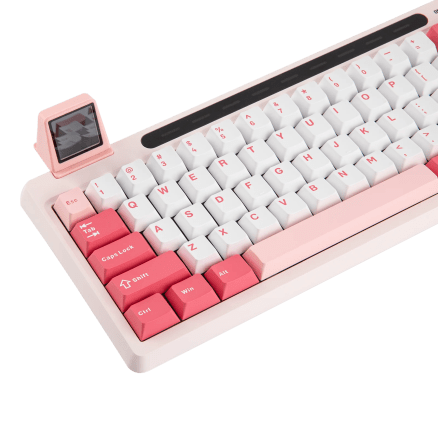
The RT65 has RGB south-facing backlights with all the usual customisation options, and more available via the free-to-use Epomaker software. It also has a lightbar across the back of the board (where the Function keys would be on a larger board). The lightbar effects can be toggled through using Fn+PgUp, or further customised via the software. The lightbar isn’t the only interesting extra feature on the RT65 though.
The RT65 comes with a detachable RT100 Mini Display, which plugs in inside the little compartment that houses the wireless dongle at the rear of the board. The screen displays time/date, battery status, and connection mode. It can also be loaded with custom images and animations via the Epomaker software.
The RT65 also has something else which I have never seen on a keyboard before: an inbuilt joystick. The joystick isn’t actually for playing games, but serves in place of a vol knob. It does a lot more than a vol knob, however, because while left / right serve as +/-, and clicking as mute/unmute, up and down also allow you to skip between tracks. But there’s even more to it than that because Fn+click on the joystick activates Mouse Mode. This means that the RT65 is a keyboard and mouse in one. Clicking the joystick in Mouse Mode = left mouse click. Now, while it’s not perfect, and you certainly wouldn’t want to be trying to cut and paste big chunks of text or anything of that nature, as a basic navigation mouse, the joystick works great.
Ultimately, the RT65 is a great looking, lovely feeling, fantastic take-anywhere portable board, and is absolutely packed with extra features. The joystick/mouse could be a real game-changer (and a lifesaver in certain situations) for a lot of coffee shop and library corner writers, and it’s a feature I hope and expect to see in other future boards.
The RT65 is available from Epomaker for $69.99 USD.
The post Epomaker RT65 keyboard review – a keyboard and mouse in one first appeared on moorereppion.
November 7, 2024
Where and when to find Moore & Reppion at Thought Bubble Comic Convention 2024

Moore & Reppion will be guests at this year’s Thought Bubble Comics Convention.
The convention will take place on Saturday, November 16th, and Sunday, November 17th, at the Harrogate Convention Centre in North Yorkshire.
Moore & Reppion will be at Table 45 in DSTLRY Hall on both days.
—
John will also be hosting a panel on Saturday:
In Stars and Shadows: Folklore and Mythology in Comics
Folklore laid the foundations of oral storytelling; for centuries tales of tradition, magic, myth and legend were passed village to village, generation to generation, culture to culture. Fascinating Folklore author John Reppion hosts B. Mure, Kieron Gillen and Juni Ba who have turned this practice to comics pages and created stories of intrigue and fantasy.
4:30 pm to 5:30 pm
Panel Room 2, Queens Suite, Harrogate Convention Centre (map)
—
We hope to see you there! 
October 22, 2024
Hellebore #12 – The Storytelling Issue OUT NOW

The landscape of these isles is embedded with stories: of how the Devil and a race of giants became architects of hills, mountains, and caves; of a host of faeries glimpsed in twilight tales; of the outlaw hero who defiantly embodies the countercultural essence of England; of an innate magic emanating from the land itself.
In this issue we look at the power of myths that keep returning to us in one guise or another, at ancient artefacts that tell tales of the deep past, at how mythmaking emerges from the land as a powerful form of protest. Follow us into the dark woods to face both your heart’s desires and terrors untold, and let us gather around the fire for an evening of storytelling.
Words by John Callow, Elizabeth Dearnley, Pen Foreman, Nick Freeman, Frazer Lee, Maria J. Pérez Cuervo, Neil Philip, John Reppion, Lisa Schneidau, Marina Warner.
Art by Courtney Brook (Light Witch) and Nathaniel Hébert.
Edited by Maria J. Pérez Cuervo.
Order now direct from Hellebore
The post Hellebore #12 – The Storytelling Issue OUT NOW first appeared on moorereppion.October 7, 2024
Epomaker P75 keyboard review – affordable aluminum luxury
The ever-generous people at Epomaker sent me one of their P75 keyboards to try out, and plugging this big fella in was quite the change of pace after reviewing the ever-so-tiny TH40.
 The P75 is an 81 key / 75% keyboard. It has an ANSI layout, is compatible with Mac, Windows and Android (and Switch and Xbox, apparently), and connects via USB C, 2.4G wireless, and Bluetooth. It also has a rotary vol knob, which is always nice. Its onboard battery has a 4000mAh capacity.
The P75 is an 81 key / 75% keyboard. It has an ANSI layout, is compatible with Mac, Windows and Android (and Switch and Xbox, apparently), and connects via USB C, 2.4G wireless, and Bluetooth. It also has a rotary vol knob, which is always nice. Its onboard battery has a 4000mAh capacity.
The P75 comes in a choice of Silver or Black & Pink colourways. I got Silver, which comes with white and blue, Cherry profile, Double Shot PBT keys. It has a kind of classic, vintage vibe about it, whilst still looking very, very modern and clean.
The P75 comes with a choice of Epomaker Zebra, Epomaker Wisteria Linear, or Epomaker Wisteria Tactile switches. I got Zebras, which have a lovely sound to them, but which feel a little bit “fast” to me. Not quite enough feedback for my own personal taste, but that’s probably because I’m nowhere near as fast a typist as I should be by now (after 20 and a bit years of writing full-time). The switches are, of course, hot-swappable, meaning that they can be easily swapped out for other 3 or 5-pin switches with no need for soldering or unnecessary messing about.
 The body of the P75 is made of CNC Aluminum with an Anodized finish (which looks and feels beautiful) and the board weighs 1.65kg, so it’s a pretty hefty bit of kit. You’re probably not going to be carrying it around just on the off-chance that you might need a keyboard.
The body of the P75 is made of CNC Aluminum with an Anodized finish (which looks and feels beautiful) and the board weighs 1.65kg, so it’s a pretty hefty bit of kit. You’re probably not going to be carrying it around just on the off-chance that you might need a keyboard.
The P75 is equipped with multiple layers of sound dampening materials, including sandwich foam, IXPE switch film, PET sound pad, sound-absorbing foam, and EVA case foam. These materials help reduce ping and rattle sounds, delivering a smooth and refined auditory experience. It doesn’t have flip-down feet, so the typing angle is fixed at 6 degrees, which is just a tiny bit flat for my taste, but not actually a problem by any stretch of the imagination.
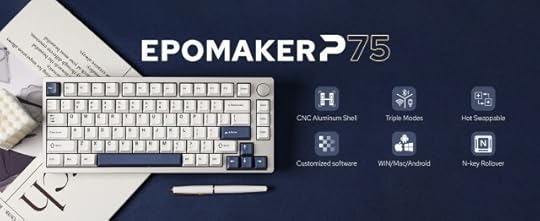 The P75 has south-facing RGB backlights which come with all the usual presets and onboard adjustable settings. Further customisation is available via Epomaker’s own free-to-use software.
The P75 has south-facing RGB backlights which come with all the usual presets and onboard adjustable settings. Further customisation is available via Epomaker’s own free-to-use software.
I can see the P75 being perfect for gamers due to its stability and speedy Zebra switches, but it definitely doesn’t look like your typical gaming keyboard. Moving from a 40% keyboard to the P75 makes it feel like I’ve gone from driving a 1960s mini to a super deluxe James Bond car with a built-in back massager and a button I can press to instantly mix up a martini. The P75 really does look, feel, and perform like a luxury, high-end keyboard, but what makes that even better is the fact that it isn’t priced like one.
The P75 is available from Epomaker for $99.99 USD.
The post Epomaker P75 keyboard review – affordable aluminum luxury first appeared on moorereppion.
Epomaker TH40 mini keyboard review – a very, very tiny keyboard indeed
The very nice people at Epomaker sent me one of their TH40 keyboards to try out. I’ve been absolutely dying to try out a mini keyboard for a long time, and the TH40 is certainly dinky.
The TH40 is a 44 key / 40% keyboard. It is compatible with Mac and Windows and connects via USB-C, Bluetooth, or 2.4G wireless.
 The TH40 comes in a choice of Black & Gold or White & Burgundy colourways. I got the Black & Gold, which manages to look sleek and stylish without being too boring and “officey”. Keycaps are PBT Dye-sub Cherry Profile, with nice clean white characters on the black keys, and black on the yellow.
The TH40 comes in a choice of Black & Gold or White & Burgundy colourways. I got the Black & Gold, which manages to look sleek and stylish without being too boring and “officey”. Keycaps are PBT Dye-sub Cherry Profile, with nice clean white characters on the black keys, and black on the yellow.
The TH40 comes with a choice of Epomaker Flamingo Switches or Epomaker Wistera Linear switches. I got the Flamingos, which I’ve tried before and which I really like. The switches are hot-swappable, meaning that they can be easily swapped out for other 3 or 5-pin switches with no need for soldering or unnecessary messing about.
 The body of the TH40 is made of black ABS Plastic and has a gasket mount design for reducing keystroke noise and minimizing sound. It incorporates Poron plate foam, an IXPE black switch pad, and bottom Poron foam, all reducing the sound transfer when typing so that your keystrokes are the only thing you hear.
The body of the TH40 is made of black ABS Plastic and has a gasket mount design for reducing keystroke noise and minimizing sound. It incorporates Poron plate foam, an IXPE black switch pad, and bottom Poron foam, all reducing the sound transfer when typing so that your keystrokes are the only thing you hear.
The TH40 weighs just 0.5 kg, which is definitely lightweight, but heavy enough to keep it sturdy on a desktop. The Keyboard actually has a little carry loop/handle attached, which is a nice touch. I couldn’t help imagining clipping it on to a 90s/early 2000s wallet chain, and pairing that with a massive pair of baggy jeans as if it was some kind of accessory, but that’s possibly just me.
The TH40 has south-facing RGB backlights, with all the usual Epomaker presets and options. Customisation comes via VIA (V2 Version) with all the programmability and multi-layer functionality you could wish for.
So, what is is like to type on such a tiny, tiny keyboard, especially for someone like me who is always so quick to bemoan the lack of a Del key on any new board? Well, the TH40 doesn’t have a Del key, and there also doesn’t seem to be any keyboard shortcut to Del, so that is a bit of a problem for me. Equally, and actually more awkwardly for me, there is no shortcut for a hyphen, so that does make writing on the TH40 a bit challenging. Those couple of issues aside, the TH40 is really, really pleasant and easy to work on. I really like the split space bar which you can rest both thumbs on, and then have easy access to the central Fn key. Fn + your QWERTY row of keys gives you all your numbers, and Fn + > Alt App and right Ctrl gives you your arrow keys. So, it really doesn’t feel as stripped down or limited as you might think it would, once you get used to it.
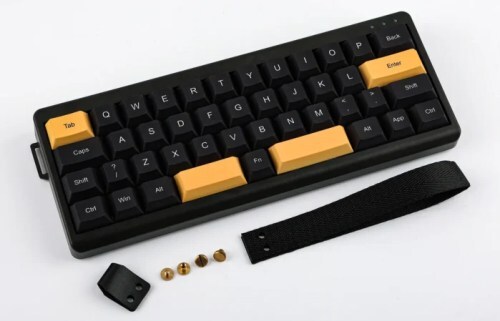 Ultimately, the TH40 is probably not a board most people would use as their full-time desktop workhorse. However, I do feel like I have adjusted to using it as such pretty quickly, and I don’t feel as if I desperately want to switch back to a different board (which I often do after testing out a board that doesn’t have everything I need on it).
Ultimately, the TH40 is probably not a board most people would use as their full-time desktop workhorse. However, I do feel like I have adjusted to using it as such pretty quickly, and I don’t feel as if I desperately want to switch back to a different board (which I often do after testing out a board that doesn’t have everything I need on it).
As a solid, great-looking, great-feeling, take-anywhere portable board with a more-than-decent 3000mAh onboard battery, the TH40 is hard to beat. I imagine all the cool kids down at the skatepark will be wearing them as wallet chain accessories very soon.
The TH40 is available from Epomaker for $79.99 USD.
The post Epomaker TH40 mini keyboard review – a very, very tiny keyboard indeed first appeared on moorereppion.Epomaker TH40 mini keyboard review
The very nice people at Epomaker sent me one of their TH40 keyboards to try out. I’ve been absolutely dying to try out a mini keyboard for a long time, and the TH40 is certainly dinky.
The TH40 is a 44 key / 40% keyboard. It is compatible with Mac and Windows and connects via USB-C, Bluetooth, or 2.4G wireless.
 The TH40 comes in a choice of Black & Gold or White & Burgundy colourways. I got the Black & Gold, which manages to look sleek and stylish without being too boring and “officey”. Keycaps are PBT Dye-sub Cherry Profile, with nice clean white characters on the black keys, and black on the yellow.
The TH40 comes in a choice of Black & Gold or White & Burgundy colourways. I got the Black & Gold, which manages to look sleek and stylish without being too boring and “officey”. Keycaps are PBT Dye-sub Cherry Profile, with nice clean white characters on the black keys, and black on the yellow.
The TH40 comes with a choice of Epomaker Flamingo Switches or Epomaker Wistera Linear switches. I got the Flamingos, which I’ve tried before and which I really like. The switches are hot-swappable, meaning that they can be easily swapped out for other 3 or 5-pin switches with no need for soldering or unnecessary messing about.
 The body of the TH40 is made of black ABS Plastic and has a gasket mount design for reducing keystroke noise and minimizing sound. It incorporates Poron plate foam, an IXPE black switch pad, and bottom Poron foam, all reducing the sound transfer when typing so that your keystrokes are the only thing you hear.
The body of the TH40 is made of black ABS Plastic and has a gasket mount design for reducing keystroke noise and minimizing sound. It incorporates Poron plate foam, an IXPE black switch pad, and bottom Poron foam, all reducing the sound transfer when typing so that your keystrokes are the only thing you hear.
The TH40 weighs just 0.5 kg, which is definitely lightweight, but heavy enough to keep it sturdy on a desktop. The Keyboard actually has a little carry loop/handle attached, which is a nice touch. I couldn’t help imagining clipping it on to a 90s/early 2000s wallet chain, and pairing that with a massive pair of baggy jeans as if it was some kind of accessory, but that’s possibly just me.
The TH40 has south-facing RGB backlights, with all the usual Epomaker presets and options. Customisation comes via VIA (V2 Version) with all the programmability and multi-layer functionality you could wish for.
So, what is is like to type on such a tiny, tiny keyboard, especially for someone like me who is always so quick to bemoan the lack of a Del key on any new board? Well, the TH40 doesn’t have a Del key, and there also doesn’t seem to be any keyboard shortcut to Del, so that is a bit of a problem for me. Equally, and actually more awkwardly for me, there is no shortcut for a hyphen, so that does make writing on the TH40 a bit challenging. Those couple of issues aside, the TH40 is really, really pleasant and easy to work on. I really like the split space bar which you can rest both thumbs on, and then have easy access to the central Fn key. Fn + your QWERTY row of keys gives you all your numbers, and Fn + > Alt App and right Ctrl gives you your arrow keys. So, it really doesn’t feel as stripped down or limited as you might think it would, once you get used to it.
 Ultimately, the TH40 is probably not a board most people would use as their full-time desktop workhorse. However, I do feel like I have adjusted to using it as such pretty quickly, and I don’t feel as if I desperately want to switch back to a different board (which I often do after testing out a board that doesn’t have everything I need on it).
Ultimately, the TH40 is probably not a board most people would use as their full-time desktop workhorse. However, I do feel like I have adjusted to using it as such pretty quickly, and I don’t feel as if I desperately want to switch back to a different board (which I often do after testing out a board that doesn’t have everything I need on it).
As a solid, great-looking, great-feeling, take-anywhere portable board with a more-than-decent 3000mAh onboard battery, the TH40 is hard to beat. I imagine all the cool kids down at the skatepark will be wearing them as wallet chain accessories very soon.
The TH40 is available from Epomaker for $79.99 USD.
The post Epomaker TH40 mini keyboard review first appeared on moorereppion.September 21, 2024
Moore & Reppion upcoming events: Oct / Nov 24

Moore & Reppion have a handful of events coming up over the next couple of months, so here are a few dates to put in your diary.
Please note that these are all ticketed events, so make sure you book as early as possible.
—
October 5th (Saturday) Folk, Comics & Stories today
The Portico Library, Manchester. 3pm – 4:30pm
Authors Leah Moore and John Reppion in conversation with Carol Ann Whitehead of The Portico Library. Discussing the role of folklore in their own work, and in art and literature in general.
—
October 12th (Saturday) Spirits of Place 2024
Williamson Art Gallery & Museum Birkenhead. 10am – 5pm
Exploring the connections between the region and the medieval poem Sir Gawain and The Green Knight, SPIRITS OF PLACE brings together a wide range of guest speakers across the fields of academia, literature, art and archaeology, following an acclaimed first symposium, held in Liverpool in 2016.
—
November 16th & 17th (Saturday & Sunday) Thought Bubble Comic Convention
Harrogate Convention Centre, North Yorkshire. 10am – 6pm (5pm Sun)
Moore & Reppion will be appearing as guests, and selling and signing books. John will also be hosting a panel on Folklore, Mythology and Comics (day and time tbc).
—
We hope to see you there! 
July 22, 2024
KiiBOOM Loop 65 keyboard – advance review
The nice people at KiiBOOM have sent me something pretty exciting. Back in March 2023, I was lucky enough to review the KiiBOOM Phantom 81, which I called “the fanciest, glitziest, most chic, stylish, and high-class-looking keyboard I have ever laid my grubby, biro-ink-stained hands upon”. Now, KiiBOOM have sent me another stunning keyboard, but this one is a bit more understated. That said, the Loop 65 is so brand new that, as I sit typing this review on it, the keyboard is not even officially out yet.
The Loop 65 is a 66 key / 65% keyboard. It has an ANSI layout, and is compatible with Mac, Windows, iOS and Android. It connects wired via USB-C, or wirelessly via 2.4G wireless or Bluetooth. Upto 3 Bluetooth devices can be stored and easily switched between using Fn+Q/W/E.
It also has a polished aluminium Vol knob (push/click to mute/unmute), but it doesn’t have a designated Del key. If you’ve read my reviews previously, you’ll know that that’s one thumbs up from me for the Vol knob, but one thumbs down for the lack of a Del.
The Loop 65 has a very decently sized 4000mAh onboard battery. Fn lights up red if the battery needs charging, and you’re looking at 100ish hours of continuous use with the backlights on once fully charged.

The Loop 65 comes in a choice of Rose Gold / Pink or Black / Grey colourways. I got the Black / Grey, which is simple but very, very stylish looking. The PBT gradient keycaps have bold white characters and look and feel great.
Because the Loop 65 isn’t even officially out yet, I don’t know what the full range of switch options will be for buyers. My board came loaded with KiiBOOM’s own Matcha Latte linears though. These feel lovely, but I would have liked to try the board with something a bit louder/heavier in order to really put the gasket mounting and five layers of padding the Loop 65 boasts to the test.
The Loop 65 ‘s switches are hot-swappable, meaning that they can be easily swapped out with no need for soldering or unnecessary messing about. I’ve stopped short of rummaging around to see if I have 66 switches going spare anywhere though.
The Loop 65 has a solid aluminium backplate, two aluminium side panels, and two contrasting colour aluminium front panels which fit together in a very aesthetically pleasing way.

The Loop 65 weighs just a little over 1.4 kg on my kitchen scales, so it’s a heavy-duty board despite its compact size. Not really surprising considering that there’s little to no plastic here: this is aluminium all the way. Four little rounded silicone feet give the board an extra bit of non-slip stability, but being able to adjust the typing angle with some flip-down feet would have been a nice little extra touch for me.
The Loop 65 has south-facing RGB LED backlights, with all the usual wonderful presets. Now, here’s where I’d usually be telling you that there are lots of extra customisation options (including Macros) available via KiiBOOM’s own software, but that is not the case here.
Unlock the full potential of your KiiBOOM Loop65 with QMK and VIA firmware, which offer an unmatched level of customization. KiiBOOM Loop 65 supports the open-source community, and have updated the code of Loop 65 on the GitHub. Thanks to the open-source codes and the compatibility of QMK/VIA, you can create complex macros, shortcuts, and lighting effects tailored to your workflow or gaming needs.

QMK (Quantum Mechanical Keyboard) is an open source community centered around developing computer input devices. The community encompasses all sorts of input devices, such as keyboards, mice, and MIDI devices.
VIA is an app which works with QMK. The Loop 65 is configurable using VIA, but the cool thing is that you can use a version of the app online without downloading anything. That is, so long as you open VIA in Chrome, Edge, or Opera (other browsers will be supported in the future).
Keeb.io has an excellent guide to the uses and purposes of both QMK and VIA
Beyond all the technical stuff, the Loop 65 is fundamentally a very, very nice and well-put-together keyboard. In many ways it’s like a super deluxe version of the EK68, which is already one of my favourite boards. The Loop 65 is a serious piece of kit, and its weight means that it’s probably going to be more of a stay-at-the-office keyboard, rather than a take-anywhere one, but that’s fine. Barring a couple of little details (the lack of a Del key and the lack of flip-out feet to adjust the typing angle) it’s hard to find fault with the Loop 65. It feels like a keyboard that a lot of writers and programmers will – and should – be very keen to get their hands on when it’s released.
 The post KiiBOOM Loop 65 keyboard – advance review first appeared on moorereppion.
The post KiiBOOM Loop 65 keyboard – advance review first appeared on moorereppion.



